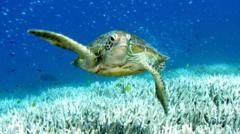Australia's Ningaloo Reef, one of the largest fringing reefs in the world, is facing a crisis as rising sea temperatures result in unprecedented coral bleaching. Located on the country's north-western coast, Ningaloo is a UNESCO World Heritage Site known for its vibrant marine life and stunning coral formations. Historically, Ningaloo has remained a shield against coral bleaching, but recent marine heatwaves have changed this situation dramatically.
The current coral bleaching event, driven by a marine heatwave that began in the Caribbean, is being compared to an "underwater bushfire" by experts. Paul Gamblin, head of the Australian Marine Conservation Society, describes the situation as "devastating" and "absolutely not normal." This year marks the first occasion that both the Great Barrier Reef and Ningaloo have experienced widespread bleaching, raising alarms among scientists.
Dr. Kate Quigley from the Minderoo Foundation explains that the symbiotic relationship between corals and algae is disrupted by warm water, leading to bleaching when corals expel the algae that give them their color. Observations indicate that prolonged exposure to elevated temperatures raises the risk of coral death, causing significant concern among marine scientists.
Despite the ongoing monitoring efforts, there is limited understanding of long-term effects. Survivability of bleached corals remains uncertain, as they typically rely on fluctuating conditions to recover. Many in the local tourism industry fear that the damage to Ningaloo will deter visitors, significantly impacting the economy.
Tourists like Jenna-Rae Clark have expressed despair at the sight of lifeless, bleached coral. With about 200,000 visitors annually, the appeal of Ningaloo hinges on its vibrant marine habitat, which is now in jeopardy due to climate-induced changes.
While the state government allows further fossil fuel projects to proceed, experts argue that fossil fuel emissions are a critical cause of climate change. The North West Shelf gas plant, one of the world's largest, symbolizes the tension between economic interests and environmental protection. Critics, including Gamblin, call for a clear commitment from authorities to prioritize the health of marine ecosystems amidst these competing forces.
Simultaneously, scientists are positioning themselves to identify solutions for the reef. Projects involving selective breeding of corals aim to enhance thermal tolerance, though researchers acknowledge that these are merely stopgaps rather than a solution to the underlying issue of emissions.
As the coral reefs, crucial to marine life and coastal protection, continue to face dire threats, experts emphasize the urgent need for action against fossil fuel dependence and climate change, ensuring their existence for future generations.
















